It’s the time of year for saving money!
Since the days when Cro-Magnon man beat rocks on the walls of his cave to make music, speaker enclosures have more or less looked the same. Whether two way or three way, speakers have always been basically rectangular. How tall, deep or wide was determined by the number and size of the drivers. That was how it was then and mostly seems to be the case today.
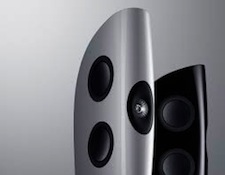 But there are exceptions to the rectangular rule. There are some radical speaker designs being introduced to the hi-fi public. The KEF Blade, so named for it’s overall shape, is designed as it is for a specific purpose. That purpose being to eliminate vibration, reduce internal standing waves and, well, produce better sound. While it has some of the familiar shape of our Cro-Magnon version, it is a serious departure from the two or three driver in the front design.
But there are exceptions to the rectangular rule. There are some radical speaker designs being introduced to the hi-fi public. The KEF Blade, so named for it’s overall shape, is designed as it is for a specific purpose. That purpose being to eliminate vibration, reduce internal standing waves and, well, produce better sound. While it has some of the familiar shape of our Cro-Magnon version, it is a serious departure from the two or three driver in the front design.
From there, you can talk about YG Acoustics, Scaena, the big MBL’s and virtually anything made by Vivid Audio’s Giya product line. Just as with the KEF Blade, there are very distinct and perfectly explainable reasons why the shape of these speakers look the way they do. Whatever their collective acoustical merits may be, it cannot be argued that their individual aesthetic design is discussion worthy. Some may like the one but hate the other. Some may like them both. But they all sound really fantastic.
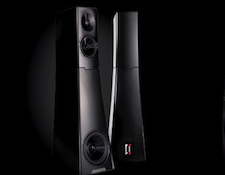 It seems that distinctive styling has even hit the mid fi market. Take, for instance the Libratone Loop Wireless Speaker. Made in Denmark, the Libratone comes standard in a round shape and covered with blue wool. Now, given that many high end enthusiasts will remove the thin, sheer cloth grills covering their drivers, I cannot understand why anyone would cover a speaker with heavy wool. But if wool is to your liking you’ll love the fact that it comes in different colors!
It seems that distinctive styling has even hit the mid fi market. Take, for instance the Libratone Loop Wireless Speaker. Made in Denmark, the Libratone comes standard in a round shape and covered with blue wool. Now, given that many high end enthusiasts will remove the thin, sheer cloth grills covering their drivers, I cannot understand why anyone would cover a speaker with heavy wool. But if wool is to your liking you’ll love the fact that it comes in different colors!
So what about the really bizarre?
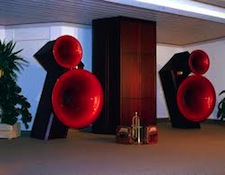 Again, presumably based on very plausible science, would be most anything from Acapella Audio Arts. Just like all art, beauty is in the eye of the beholder so if you like BIG, REALLY BIG horns, this is for you. Despite how they may look, these radical speakers do, in fact, sound remarkable. Moving on down the bizarre road…
Again, presumably based on very plausible science, would be most anything from Acapella Audio Arts. Just like all art, beauty is in the eye of the beholder so if you like BIG, REALLY BIG horns, this is for you. Despite how they may look, these radical speakers do, in fact, sound remarkable. Moving on down the bizarre road…
]]>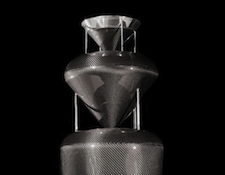 Consider the AlkemiaVero Holophonic Omnidirectional loudspeaker system. Using a design first set forth by Hugo Zuccarelli in the 1980’s, the AlkemiaVero claims sonic excellence through its holophonic design. It just happens to look like something I used to see flying around on the show Lost In Space from the late 1960’s. Where is Dr. Smith when you need him?
Consider the AlkemiaVero Holophonic Omnidirectional loudspeaker system. Using a design first set forth by Hugo Zuccarelli in the 1980’s, the AlkemiaVero claims sonic excellence through its holophonic design. It just happens to look like something I used to see flying around on the show Lost In Space from the late 1960’s. Where is Dr. Smith when you need him?
Saving the best for last, I give you the clear winner for “bizarreness”- the Acadian Audio 100-Watt Pnoe Speaker. These things may be the best sounding speaker on Earth- personally I’ve never heard them. Since this is not about sound but design, your friends would certainly terrorize you if they saw them in your home. Having a set of these things would bring equal ridicule as going into a prison wearing tight shorts and a pink shirt. I have visions of small children and cats climbing up into them. Their design premise is to not restrict the flow of the sound waves as they leave the enclosure. Well, OK, that sounds good. No pun intended.
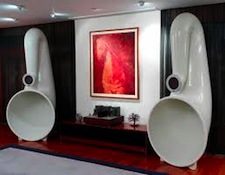 Design of audio components appears to be increasingly avant-garde. There are all manner of components made in non traditional shapes and materials. Like speakers, amps, preamps, DAC’s and other components are not necessarily made in nice, traditional boxes any more. I’m quite certain there are many that champion this and feel that it is about time. Many audiophiles look for a style with sonic excellence approach. But the question must be asked if one has anything to do with the other? Can quality sound only be more efficiently achieved by using a design such as the Acadian Audio 100-Watt Pnoe Speaker? Or is the shape of this speaker so radical that the manufacturer hopes it will attract customers solely because it is a radical design?
Design of audio components appears to be increasingly avant-garde. There are all manner of components made in non traditional shapes and materials. Like speakers, amps, preamps, DAC’s and other components are not necessarily made in nice, traditional boxes any more. I’m quite certain there are many that champion this and feel that it is about time. Many audiophiles look for a style with sonic excellence approach. But the question must be asked if one has anything to do with the other? Can quality sound only be more efficiently achieved by using a design such as the Acadian Audio 100-Watt Pnoe Speaker? Or is the shape of this speaker so radical that the manufacturer hopes it will attract customers solely because it is a radical design?
We have had nice, simple, mostly rectangular boxes since the dawn of audio. This has been a design premise that has served the audio enthusiast well for a long time. Where we go from here remains to be seen. Perhaps the tried and true approach will remain with us for years to come. Or maybe we’ll go the way of the Acadian Audio system. Who knows, maybe they have a better way? Just keep the kids and cats away from them.





